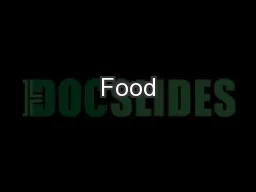

T echnology P resentation By Olivia Brennan My Dietary Related Disease that I have chosen is C o e l i a c D i s e a s e What is Coeliac Disease Coeliac disease commonly affects people from around the world Coeliac disease is a digestive disease that harms the small ID: 220888
Download Presentation The PPT/PDF document "Food" is the property of its rightful owner. Permission is granted to download and print the materials on this web site for personal, non-commercial use only, and to display it on your personal computer provided you do not modify the materials and that you retain all copyright notices contained in the materials. By downloading content from our website, you accept the terms of this agreement.
Slide1
Food
T
echnology
P
resentation;
By Olivia BrennanSlide2
My Dietary Related Disease that I have chosen is:
C
o
e
l
i
a
c
Disea
seSlide3
What is
Coeliac
Disease?
Coeliac disease commonly affects people from around the world. Coeliac disease is a digestive disease that harms the small intestine as well as interfering with the absorption of nutrients. It is the bodies inability to tolerate gluten. Gluten is a protein found in wheat, rye and barley. Gluten is found in foods commonly eaten each day as well as in products such as; medicines, lip balms and vitamins.Slide4
What is the cause of Coeliac disease?
Coeliac disease is caused by the bodies sensitivity towards the product gluten. The body reacts to the gluten/ products of gluten in the food consumed, which in turn results in the immune system reacting to dietary gluten. It is not yet known the exact answer to the cause of this eating disorder, though it is thought to be both genetic and environmental factors that both play an important role in causing this disease. Slide5
What are the symptoms of this eating disorder?
There are many different symptoms of coeliac
disease
because the symptoms are specific from person to person, though most symptoms are likely to take affect in the stomach. The symptoms are very varied between child
and adult. The symptoms are varied due to factors such as: whether
a person was breastfed, as well as the amount of gluten in foods they consumed. Some of the more common symptoms include
:VomitingConstipation
Weight LossBone or joint painSeizuresAbdominal bloating and pain
Growth delay in childrenFatigueMouth ulcers Slide6
What are the consequences of Coeliac disease?
Just like the symptoms of Coeliac disease, the consequences and health problems that may arise also differ from person to person. Undiagnosed coeliac disease is incredibly dangerous, being life threatening. Unfortunately people with Coeliac disease tend to develop or have other underlying health issues, which may include:
Addison's
disease (when the glands produce critical hormones that become damaged)
Type 1 diabetesAutoimmune liver disease Osteoporosis
Many of these underlying health issues, are in some cases also thought to be genetically related.Though there may be huge differences in the consequences of coeliac disease between affected people, the one common consequence is that each person has an inability to consume gluten.Slide7
Unfortunately there are no known preventatives for coeliac disease, just like
other hereditary
diseases. However,
havinging an early diagnosis of this disease, as well as keeping to a gluten free diet can be the keys to decreasing this disease’s impact on your health. Someone with coeliac
disease can learn from a dietarian how to read ingredient lists and identify foods that contain gluten in order to make informed decisions at the grocery store and when eating out. For many people, following a gluten free diet will eradicate all of the symptoms. Though people with coeliac disease will need to remain on the gluten free diet which will include; totally avoiding
wheat, rye, barley, oats, and a few other lesser known ingredients for the rest of their lives in order to keep their bodies healthy.
Are there any preventative measures for coeliac disease? Slide8
1.
Coeliac Australia-’’enhance
the quality of life of people requiring a gluten free diet for life and to encourage and support research towards a cure’’ .2.The Coeliac Society Of New South Wales Inc- Support, counselling and
spread awareness and information to people with coeliac disease, this group works around all of Australia, having offices in every state.3. Coeliac.com- Founded in 1995, Coeliac.com has the goal
- ‘’To help as many people as possible with coeliac
disease get diagnosed and live a happy, healthy gluten-free life’’. 4. Public health units/ community health centres- These are found all over Sydney and on the Central Coast and Newcastle.
5. Gluten intolerance centre of North America- Providing support and education to people with coeliac disease allowing the patients to live long healthy lives even with this disease.6. National Foundation for Coeliac Awareness- Dedicated to raising money for those with this disorder for research as well as providing support.
7. Raising our Coeliac kids (R.O.C.K)- Raising Our Coeliac Kids offers free support to families and friends of kids with
coeliac disease, as well as dealing with the psychological impact of growing up with coeliac disease, and more.
8. Coeliac spruce association - Study the disease providing families and people with support.
What local/national support groups/contacts for individuals suffering from coeliac disease;Slide9
Some quick facts about Coeliac Disease;
Coeliac is a protein found in wheat, barley and rye.
There is no treatment for coeliac disease, the best outcome results from a life long gluten free diet.
Gluten is a mixture of two proteins, gliadin and
gluten, which when mixed with water become sticky and so forms the familiar texture of dough made from wheat and rye flour.Slide10
Thank you for watching! By Olivia Brennan.